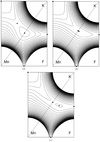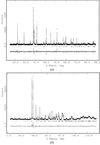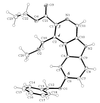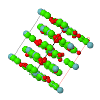issue contents
August 2004 issue

Cover illustration: Crystal packing diagram of 1,4-benzoquinone with Hirshfeld surfaces. The translucent gray surfaces illustrate the nature of these novel surfaces and how they envelop each molecule and reflect the presence of neighbouring molecules. Colours mapped on the central surface represent the distance from the surface to the nearest nucleus in an adjacent molecule: red (shortest), through green, to blue (longest) (McKinnon, Spackman & Mitchell, Acta Cryst. B, in preparation).
research papers
Download citation


Download citation


Three accurate X-ray diffraction experiments were carried out to determine the temperature dependence of the electron density in cubic perovskite KMnF3, from room temperature to just above that of the phase transition to the tetragonal structure (186 K), and to correlate the parameters of the critical points with the phase-transition mechanism.
Simulation studies on changes in structure with a variation in q revealed that various large-scale regularities larger than the modulation wavelengths are formed in the incommensurate structures of Ca2CoSi2O7.
Download citation


Download citation


The structure of a high-pressure phase of vanadium pentoxide, β-V2O5, has been studied by X-ray and neutron powder diffraction and HRTEM. Structural relationships between α- and β-V2O5, and between β-V2O5- and B-Ta2O5-type structures are discussed.
Download citation


Download citation


The structures of Li3V6O13 and Li3+δV6O13, δ ≃ 0.3, have been determined by single-crystal X-ray diffraction. A mechanism is proposed for lithium insertion in the composition range Li3V6O13–Li6V6O13.
Download citation


Download citation


The redistribution of bonding electron density in Si N
N was studied by means of three synchrotron X-ray experiments and a theoretical plane-wave study.
was studied by means of three synchrotron X-ray experiments and a theoretical plane-wave study.
The experimental results on X-ray structure determination in complexes of 2,6-dichlorophenols with different pyridines are analyzed in relation to the degree of proton transfer. Theoretical trends are described on the basis of B2LYP/6-31G(d,p) calculations.
Download citation


Download citation


The title compound crystallizes in the space group P21/n and may be described by a partial ordering of a 1:1 disordered P21/a parent structure with the c axis halved. The structure can be redescribed as 0.732 (1) of an ordered P21/n structure and 0.268 (1) of a 1:1 disordered P21/a structure with atom positions in the asymmetric unit that are significantly non-identical.
Experimental evidence of the Osp3 ester acceptor function in hydrogen bonds extracted from the Cambridge Structural Database is shown. Geometrical data are analysed in view of known hydrogen-bond criteria. The observed data revealing the acceptor function of the Osp3 ester are in agreement with the ab initio-based energy calculations performed by Lommerse et al. [(1997>), J. Comput. Chem. 18, 757–774].
Download citation


Download citation


Crystals of KNI-272, a highly selective HIV protease inhibitor, were grown in three different solvent systems. The local conformations around the hydroxymethylcarbonyl moiety were similar in all three forms with a remarkable similarity in the C-terminal region. Their conformational characteristics of the uncomplexed forms resembled those of the inhibitor within the KNI-272–HIV protease complex. This suggests that the structure of the C-terminal region of KNI-272 is rigid or very stable.
Download citation


Download citation


The title phenolic diacid presents an elaborate two-dimensional hydrogen-bonding pattern, in which its water of monohydration is intimately involved. The title compound's high phenol acidity is reflected in its monoanionic tetraphenylphosphonium salt, where charge is stabilized on the phenol oxygen by symmetrical hydrogen-bond donation from both ortho groups.
The volumes of more than 100 000 molecules in organic crystals have been calculated using the Voronoi–Dirichlet procedure. It is shown in this report that the average volumes are nearly equal to the corresponding values in homomolecular crystals and the reasons for the variations in molecular sizes are discussed.
Download citation


Download citation


The crystal structure of the hygroscopic anhydrous form of α-lactose is solved ab initio at 293 K from powder X-ray diffraction data. A real-space method (Monte Carlo simulated annealing), Rietveld refinements with geometric soft restraints, and energy minimization calculations have been used.
Download citation


Download citation


Open  access
access
 access
accessHard and soft hydrogen bonds in substituted trehalose derivatives generate supramolecular structures in one, two and three dimensions.
Download citation


Download citation


Open  access
access
 access
accessIodo-N-(nitrobenzyl)anilines, O2NC6H4CH2NHC6H4I, can exhibit hydrogen bonds of four types, N—H⋯O, C—H⋯O, N—H⋯π(arene) and C—H⋯π(arene), as well as iodo⋯nitro and aromatic π⋯π stacking interactions. The resulting supramolecular structures can be one-, two- or three-dimensional.
Download citation


Download citation


A structural comparison study by superimposition techniques, integrated by the analysis of affinity data, is presented in this paper in order to obtain a deeper insight into the structure–activity relationships in β-carbolines.
addenda and errata
Free 

An addendum to the paper by Trzesowska et al. (2004>). Acta Cryst. B60, 174–178.


 journal menu
journal menu

































